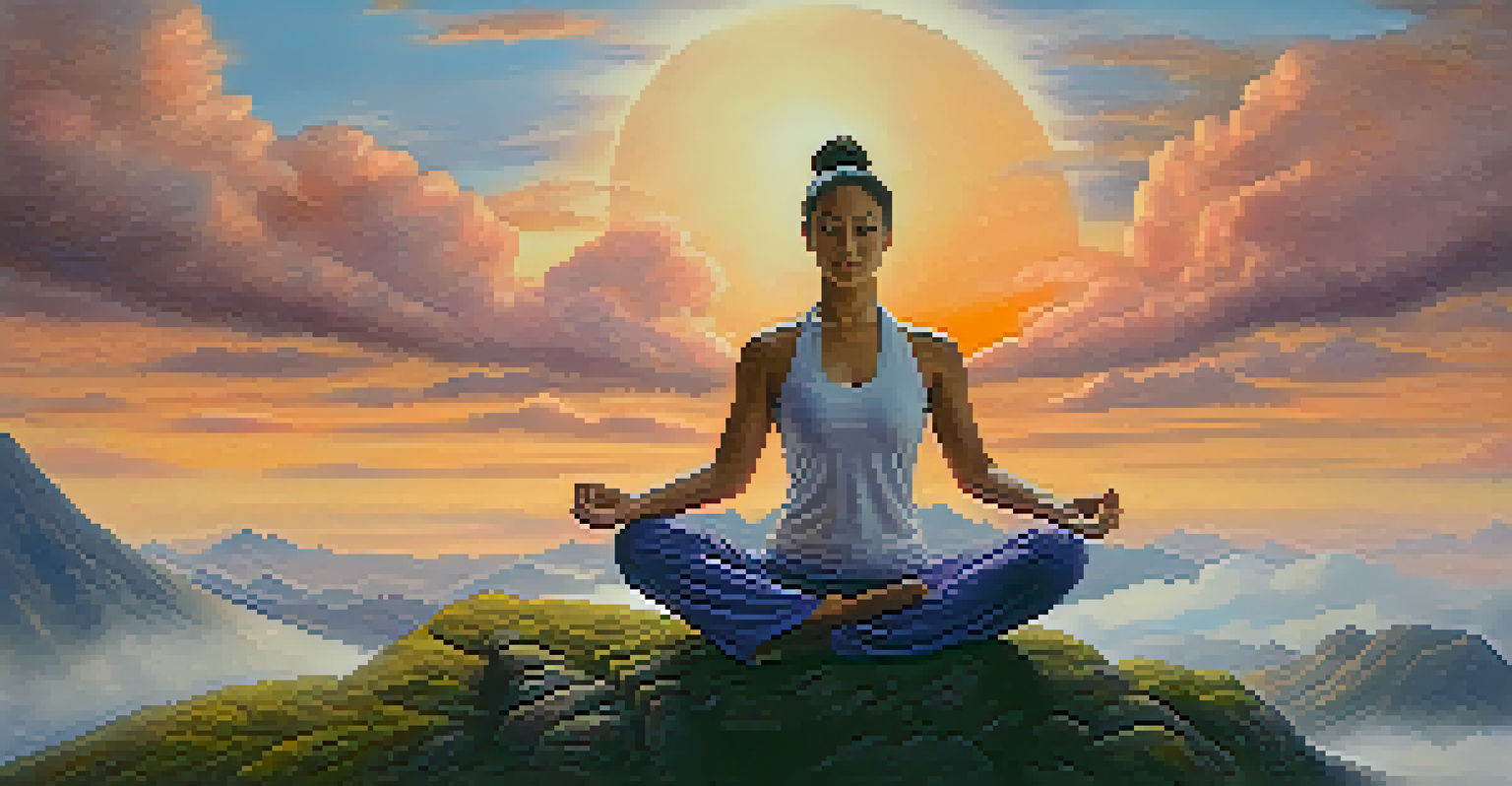Comparative Study of Yoga and Taoism: Philosophical Insights

Introduction to Yoga and Taoism: A Philosophical Overview
Yoga and Taoism are ancient practices with rich philosophical roots. While Yoga originates from India, focusing on union with the divine, Taoism stems from China, emphasizing harmony with the Tao, or 'the way.' Both philosophies offer unique paths to self-realization and spiritual growth, but they approach these goals from distinct angles.
Yoga is the journey of the self, through the self, to the self.
At their core, both traditions teach the importance of balance and inner peace. Yoga utilizes physical postures and meditation to align the body, mind, and spirit, while Taoism encourages a natural flow with the universe, promoting spontaneity and simplicity. Despite these differences, the ultimate aim remains similar: achieving a deeper understanding of oneself and the universe.
Exploring these philosophies side by side not only enriches our understanding of each but also allows us to appreciate the universal quest for enlightenment. This article will delve into their key principles, practices, and how they can complement each other in our spiritual journeys.
Key Philosophical Principles of Yoga
Yoga is built on several philosophical foundations, with the Yoga Sutras of Patanjali being one of its most influential texts. These sutras outline the eight limbs of yoga, which guide practitioners toward self-discipline, ethical behavior, and meditation. The ultimate goal is to achieve 'kaivalya' or liberation, a state of profound inner peace and self-realization.

Central to Yoga's philosophy is the concept of 'dharma,' or duty, which encourages individuals to live in accordance with their true nature and responsibilities. This commitment to personal development fosters a sense of purpose and fulfillment, steering practitioners toward a more meaningful life. By embracing practices such as asana (postures) and pranayama (breath control), individuals can cultivate both physical and mental resilience.
Yoga and Taoism Promote Balance
Both Yoga and Taoism emphasize the importance of achieving balance and inner peace as pathways to self-realization.
The philosophical insights of Yoga emphasize the interconnectedness of all beings and the importance of compassion. This awareness helps individuals transcend their ego and fosters a sense of unity with others, ultimately leading to spiritual growth.
Essential Concepts of Taoism
Taoism is grounded in the concept of 'Tao,' which can be understood as the fundamental principle that underlies the universe. It represents the natural order of things, advocating for a lifestyle that aligns with this flow. The foundational text, the Tao Te Ching, emphasizes simplicity, humility, and compassion as essential virtues.
The journey of a thousand miles begins with one step.
One of the core tenets of Taoism is 'wu wei,' or effortless action, which encourages individuals to act in harmony with the natural world rather than against it. This principle teaches that by letting go of rigid control, we can achieve our goals more effectively and maintain a sense of peace. The idea is akin to a river flowing smoothly around obstacles, illustrating the power of adaptability.
Taoism also emphasizes the yin-yang concept, representing the balance of opposites in the universe. This interplay of forces highlights the importance of embracing both sides of existence, such as light and dark, active and passive, to achieve harmony within oneself and with the world.
Similarities Between Yoga and Taoism
Despite their distinct origins, Yoga and Taoism share several similarities in their philosophical approaches. Both emphasize the importance of inner peace and self-awareness as pathways to enlightenment. Practitioners of either tradition often engage in meditation, which serves as a tool for self-reflection and connection to a higher consciousness.
Additionally, both philosophies advocate for a balanced lifestyle that nurtures the body, mind, and spirit. This holistic approach encourages individuals to cultivate healthy habits, such as mindful eating and regular physical activity, which ultimately contribute to overall well-being. The emphasis on balance resonates in both Yoga's concept of 'sattva' (purity) and Taoism's yin-yang philosophy.
Philosophical Views on the Self
Yoga seeks to transcend the ego for liberation, while Taoism encourages embracing the self as part of the natural order.
Moreover, the teachings of both Yoga and Taoism promote the idea of interconnectedness. They encourage individuals to recognize their place within the larger tapestry of life, fostering a sense of community and compassion toward others. This shared understanding enriches the spiritual journey and enhances personal growth.
Contrasting Views on the Self: Yoga vs. Taoism
In Yoga, the self is often viewed as a distinct entity that must be transcended to achieve liberation. The practice aims to dissolve the ego and unite the individual with the universal consciousness. This journey towards 'samadhi' or bliss involves rigorous self-discipline and introspection, focusing on the individual's relationship with the divine.
On the other hand, Taoism presents a more fluid perspective on the self. It suggests that the self is an integral part of the greater whole and should not be overly distinguished from nature. By embracing this understanding, practitioners learn to flow with life's currents rather than resist them, promoting a sense of peace and acceptance.
This contrast highlights the differing approaches to personal identity within both philosophies. While Yoga emphasizes the need to overcome the self, Taoism encourages embracing it as part of the natural order. This nuanced understanding can enrich a practitioner's journey, allowing for a more comprehensive exploration of self and spirit.
Practical Applications in Daily Life
Yoga and Taoism offer practical tools that can be integrated into daily life for enhanced well-being. Yoga practices, such as asanas and meditation, can be performed regularly to cultivate physical strength and mental clarity. By establishing a consistent routine, individuals can experience the profound benefits of these practices on their overall health.
Taoism, with its emphasis on living in harmony with nature, encourages individuals to adopt a lifestyle that respects the environment and promotes sustainability. Simple practices, like mindful gardening or spending time outdoors, can foster a deeper connection with nature and enhance one’s sense of peace and fulfillment.
Practical Tools for Daily Life
Integrating the practices of Yoga and Taoism into daily routines can enhance physical, mental, and spiritual well-being.
By blending the teachings of both Yoga and Taoism, individuals can create a balanced lifestyle that nurtures their physical, mental, and spiritual well-being. This holistic approach not only enriches personal growth but also contributes to a greater sense of community and interconnectedness with the world.
Conclusion: The Path Forward through Yoga and Taoism
In conclusion, the comparative study of Yoga and Taoism reveals profound insights into the human experience. Both philosophies, while distinct in their teachings, offer valuable lessons on balance, self-awareness, and interconnectedness. By embracing the principles of each tradition, individuals can embark on a transformative journey toward personal growth and spiritual enlightenment.
As we navigate the complexities of modern life, integrating the teachings of Yoga and Taoism can provide a roadmap for inner peace and fulfillment. Whether through the disciplined practice of Yoga or the effortless flow of Taoism, the journey toward self-discovery and harmony is accessible to everyone.

Ultimately, the exploration of these ancient philosophies underscores the timeless quest for understanding and connection. By fostering a deeper awareness of ourselves and the world around us, we can cultivate a more meaningful and harmonious existence.